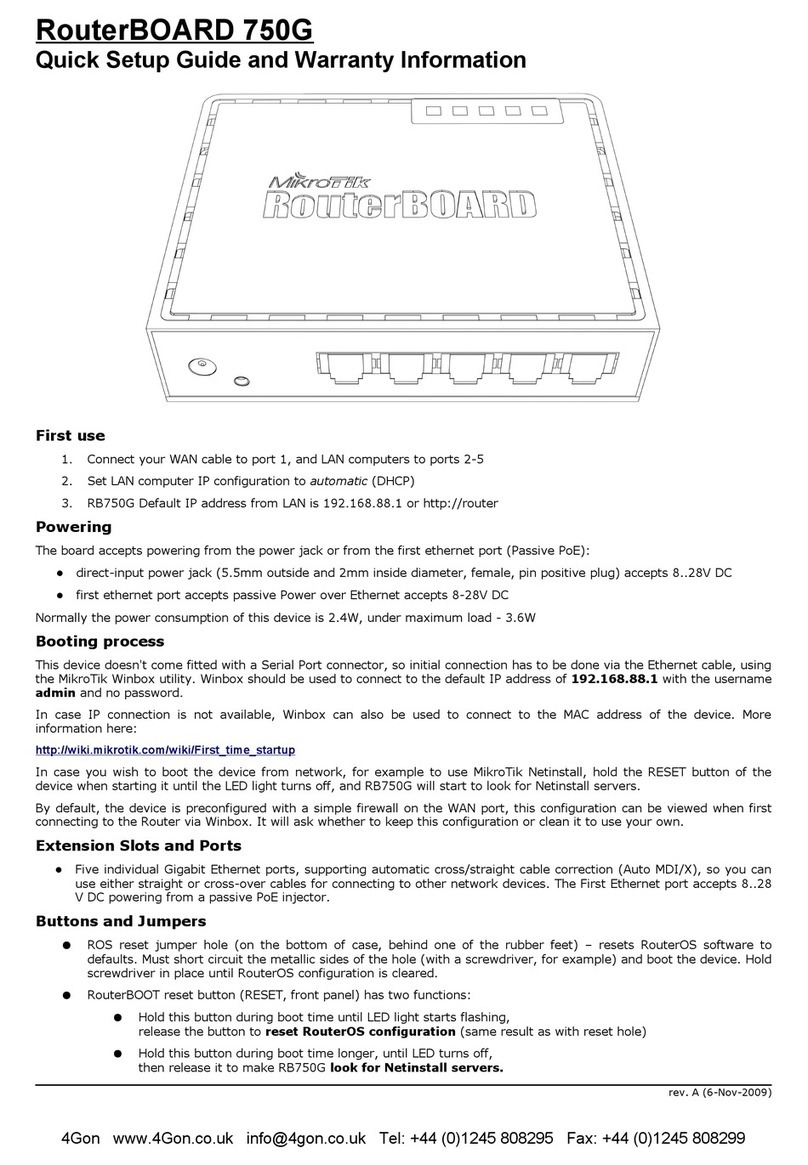
RouterBOARD 493
Quick Setup Guide and Warranty Information
Assembling the Hardware
●Insert the MiniPCI cards. RouterBOARD 493 provides three MiniPCI slots.
●Connect antenna cables to the MiniPCI cards.
●Install the board in a case and connect other peripherals and cables.
●Plug in po er cable to turn on the board.
Powering
The board accepts po ering from the po er jack, or from the LAN1 Ethernet port:
●direct-input po er jack J901 (5.5mm outside and 2mm inside diameter,
female, pin positive plug) accepts 9..28 V DC (overvoltage protection starts
at 28.5V-29V).
●LAN1 Ethernet port J601 accepts 9..28 V DC input (at the board; higher
voltage is needed to compensate for po er loss on long cables – at least
18V suggested) from non-standard (passive) Po er over Ethernet injectors
(no po er over datalines). The board does not ork ith IEEE802.3af
compliant 48V po er injectors.
CAUTION: all po er inputs are al ays active, but only one of them may be used
at a time to avoid damage of equipment.
The maximum output of the po er supply available for extension cards is
normally 10W (3.0A).
ooting process
First, RouterBOOT loader is started. It displays some useful information on the
onboard RS232C asynchronous serial port. The serial port is set by default to
115200bit/s, 8 data bits, 1 stop bit, no parity.
Note that the device does not fully implement the hard are (RTS/CTS) flo control,
so it is suggested to try to disable hard are flo control in the terminal emulation
program in case the serial console does not ork as expected, and if it does not
help, make a ne cable using the pinout given in the User's manual.
The loader may be configured to boot the system from the onboard NAND, and/or
from net ork. See the respective section of User's manual on ho to configure
booting sequence and other BIOS parameters.
DHCP or BOOTP (configurable in loader) protocols allo the RouterBOARD 192
series board to get an initial IP address, and provide the address of a TFTP server to
do nload an ELF boot image from. It is especially useful for soft are installation.
See the User's manual for more information and protocol details. Note that you
must connect the RouterBOARD you ant to boot and the BOOTP/DHCP and TFTP
servers to the same broadcast domain (i.e., there must not be any routers bet een
them – they must be on the same Ethernet s itch).
Extension Slots and Ports
●Nine Ethernet ports, supporting automatic cross/straight cable correction
(Auto MDI/X), so you can use either straight or cross-over cables for
connecting to other net ork devices. The first Ethernet port (marked ith the
“PoE” label and detached from the 8-port block) accepts 9..28 V DC po ering from a passive PoE injector. The other
eight Ethernet ports (placed as a block) do not support PoE po ering.
●Three MiniPCI Type IIIA/IIIB ports ith 3.3V po er signaling.
●DB9 RS232C asynchronous serial port.
Operating System Support
Currently tested operating system is MikroTik RouterOS (starting from ROS version 3.0).
rev. A (17-Sep-2008)
4Gon
www.4Gon.co.uk
[email protected] Tel:
+44
(0)1245
808295
Fax:
+44
(0)1245
808299





















